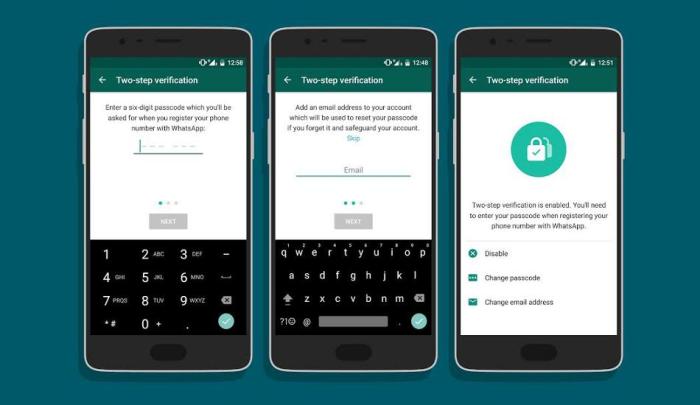With WhatsApp Security Best Practices Guide leading the way, we’re stepping into a realm of digital protection, uncovering hidden threats, and empowering you to safeguard your WhatsApp experience like never before. Join us on this captivating journey as we unveil essential strategies to keep your conversations secure and your data protected.
In the following paragraphs, we’ll delve into the depths of WhatsApp security, providing clear and concise guidance to help you navigate the complexities of this widely used messaging platform. Get ready to enhance your online safety and maintain peace of mind while connecting with loved ones and managing your digital life.
Introduction
Maintaining WhatsApp security is paramount in today’s digital landscape. As a widely used messaging platform, it carries sensitive information, making it a potential target for cyber threats. Understanding and implementing best practices can safeguard your privacy and protect your data from unauthorized access.
WhatsApp’s popularity and ease of use come with potential risks. Unsecured usage can expose your personal information, conversations, and media to malicious actors. These threats include phishing scams, malware distribution, and unauthorized account access.
Potential Risks and Threats
- Phishing Scams:Fraudulent messages disguised as legitimate communications from WhatsApp or other entities, attempting to steal personal information or account credentials.
- Malware Distribution:Malicious links or attachments sent through WhatsApp can infect devices with viruses, spyware, or other harmful software.
- Unauthorized Account Access:Weak passwords or compromised devices can allow unauthorized individuals to gain access to your WhatsApp account, potentially intercepting messages or impersonating you.
Enable Two-Factor Authentication

Enabling two-factor authentication adds an extra layer of security to your WhatsApp account, making it harder for unauthorized individuals to access it even if they have your password.
To enable two-factor authentication on WhatsApp:
- Open WhatsApp and tap on the three dots in the top right corner.
- Tap on “Settings” and then “Account”.
- Tap on “Two-step verification” and then “Enable”.
- Enter a six-digit PIN and tap on “Next”.
- Enter your email address and tap on “Next”.
- You will receive an email with a verification code. Enter the code and tap on “Next”.
- Two-factor authentication is now enabled for your WhatsApp account.
When you enable two-factor authentication, you will be prompted to enter your PIN whenever you log in to WhatsApp on a new device. This helps to ensure that only you can access your account, even if someone else has your password.
Use a Strong Passcode
Securing your WhatsApp account with a robust passcode is essential to safeguard your privacy and data. A strong passcode acts as a barrier against unauthorized access, ensuring that only you can access your account.
To create a secure passcode, follow these guidelines:
Length
- Use a passcode with at least six characters, preferably eight or more.
Complexity
- Include a combination of lowercase and uppercase letters, numbers, and symbols.
- Avoid using common words, phrases, or personal information that can be easily guessed.
Uniqueness
- Do not reuse passcodes from other accounts.
Regular Updates
- Change your passcode periodically, especially if you suspect it may have been compromised.
Keep WhatsApp Updated

Keeping WhatsApp updated to the latest version is crucial for maintaining the security of your account and protecting your privacy. WhatsApp regularly releases updates that address security vulnerabilities, improve privacy features, and enhance the overall user experience.
By using the latest version of WhatsApp, you can benefit from the following security advantages:
Improved Security Measures
- Updated versions of WhatsApp include patches for security vulnerabilities that could be exploited by attackers to gain access to your account or compromise your data.
- WhatsApp continuously works to improve its encryption protocols, ensuring that your messages and calls remain private and secure.
Enhanced Privacy Features
- WhatsApp updates often introduce new privacy features that give you more control over your data and who can see your information.
- For example, recent updates have added features like disappearing messages and the ability to control who can add you to groups.
Better User Experience
- In addition to security and privacy improvements, WhatsApp updates also include new features and enhancements that improve the overall user experience.
- These updates can include things like improved call quality, new messaging features, and a more user-friendly interface.
To ensure you have the latest version of WhatsApp, regularly check the app store on your device for updates. By keeping WhatsApp updated, you can protect your account, enhance your privacy, and enjoy the best possible user experience.
Be Cautious of Suspicious Links

WhatsApp is a popular messaging platform that allows users to send and receive messages, photos, videos, and documents. However, it’s important to be aware of the potential risks associated with clicking on suspicious links in WhatsApp messages.
Cybercriminals often use WhatsApp to spread malware, phishing scams, and other malicious content. They may send you a link that appears to be from a legitimate source, such as a bank or a government agency. However, when you click on the link, you may be directed to a malicious website that can infect your device with malware or steal your personal information.
Identifying Suspicious Links
- Check the sender.Be wary of messages from unknown or unfamiliar senders.
- Inspect the link.Hover over the link to see the full URL. If the URL looks suspicious or unfamiliar, do not click on it.
- Be cautious of shortened URLs.Cybercriminals often use URL shorteners to hide the true destination of a link. If you’re not sure where a shortened URL will take you, do not click on it.
- Trust your instincts.If something about a link feels suspicious, it probably is. Do not click on it.
Control Privacy Settings: WhatsApp Security Best Practices Guide
WhatsApp offers a range of privacy settings to help you control who can see your personal information and activities. By adjusting these settings, you can enhance the security of your account and protect your data.
To access the privacy settings, tap on the “Settings” icon in the bottom right corner of the WhatsApp screen, then select “Privacy”.
Last Seen and Online Status
These settings control who can see when you were last online and whether you are currently online. You can choose to make this information visible to everyone, your contacts only, or nobody.
Profile Photo
You can choose who can see your profile photo. Options include everyone, your contacts only, or nobody.
About
This section allows you to write a short bio about yourself. You can choose who can see this information, such as everyone, your contacts only, or nobody.
Status
WhatsApp statuses are short updates that disappear after 24 hours. You can control who can see your statuses by choosing from the same options as above.
Read Receipts
Read receipts show a blue checkmark next to messages that have been read. You can disable read receipts if you don’t want others to know when you’ve read their messages.
Groups
You can control who can add you to groups. Options include everyone, your contacts only, or nobody.
Location Sharing
You can choose to share your location with specific contacts or for a limited time.
Manage Group Permissions

Group permissions in WhatsApp play a crucial role in maintaining the security and privacy of your conversations. Managing these permissions effectively ensures that only authorized individuals have access to your group chats.
To manage group permissions, open the group chat and tap on the group name at the top of the screen. Select “Group Info” and then “Participants.” Here, you can add or remove members, as well as adjust group settings such as who can send messages, change the group icon, or add new participants.
Adding and Removing Members
To add a new member to a group, tap on the “Add Participant” button and select the contacts you want to add. You can also share a group invite link with others, allowing them to join the group by clicking on the link.
To remove a member from a group, tap on their name in the “Participants” list and select “Remove.” Only group admins can remove members.
Adjusting Group Settings
In the “Group Info” section, you can adjust various group settings, including:
- Group Icon:Change the group’s display picture.
- Group Description:Add a brief description of the group’s purpose.
- Admin Settings:Control who can become admins and what permissions they have.
- Participant Settings:Restrict who can send messages, change the group icon, or add new participants.
By managing group permissions carefully, you can ensure that your WhatsApp groups remain secure and private.
Use End-to-End Encryption
End-to-end encryption (E2EE) is a crucial security measure that ensures your WhatsApp messages, calls, and video calls remain private and secure. With E2EE, messages are encrypted on your device and decrypted only on the recipient’s device, preventing third parties, including WhatsApp, from accessing the content.
Verifying End-to-End Encryption, WhatsApp Security Best Practices Guide
To verify that E2EE is enabled for a specific WhatsApp conversation:
- Open the chat and tap on the contact’s name or group info.
- Scroll down to “Encryption” and check if it says “Messages and calls are end-to-end encrypted.”
- A green lock icon next to the contact’s name or group chat also indicates E2EE is active.
9. Back Up Chats Regularly
Backing up your WhatsApp chats regularly ensures that you won’t lose important messages, media, and documents in case of accidental deletion or device loss.There are two main ways to back up your WhatsApp chats:
Back Up to iCloud (iOS)
- Open WhatsApp and go to “Settings” > “Chats” > “Chat Backup”.
- Tap “Back Up Now” to create a manual backup.
- Enable “Auto Backup” to schedule automatic backups on a daily, weekly, or monthly basis.
Back Up to Google Drive (Android)
- Open WhatsApp and go to “Settings” > “Chats” > “Chat Backup”.
- Tap “Back Up to Google Drive” and select a backup frequency (daily, weekly, monthly, or never).
- Tap “Back Up” to create a manual backup.
Summary

As we conclude our exploration of WhatsApp security best practices, remember that vigilance and proactive measures are key to safeguarding your digital footprint. By implementing the strategies Artikeld in this guide, you’ll gain the confidence to navigate WhatsApp with ease, knowing that your privacy and security are firmly in your control.
Embrace these practices, stay informed about evolving threats, and continue to prioritize your online well-being.
FAQ Insights
What’s the most important WhatsApp security feature?
Two-factor authentication adds an extra layer of protection by requiring a verification code when logging in from a new device.
How often should I back up my WhatsApp chats?
Regular backups ensure your conversations are safe in case of device loss or damage. Back up frequently, or enable automatic backups for peace of mind.